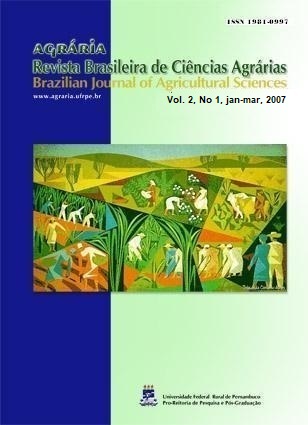Nodulação e fixação biológica de nitrogênio de acessos de amendoim com estirpes nativas de rizóbios
DOI:
https://doi.org/10.5039/agraria.v2i1a789Palavras-chave:
Arachis hypogaea, especificidade simbiótica, rizóbio, FBNResumo
A maximização da fixação biológica de nitrogênio (FBN) em espécies tropicais, costuma ser pouco eficiente uma vez que essas espécies nodulam facilmente com rizóbios nativos. O sucesso da seleção de uma simbiose eficiente é dependente do conhecimento da variabilidade genética do macro e do microssimbionte. Objetivou-se, neste estudo, avaliar parâmetros relacionados à capacidade de nodulação e fixação biológica de nitrogênio entre acessos de amendoim. Nove acessos de amendoim, cultivados em Aargissolo e Planossolo, foram utilizados, sendo avaliado o número e a massa de nódulos, a massa da parte aérea e da raiz, o nitrogênio (N) acumulado, e a redução de acetileno, sob o efeito da população nativa de rizóbios. Os acessos IAC Tatu-ST, IAC 886 Runner, Sapucaia Vermelha, Sapucaia Bege e CV Tatuí, mostraram desempenho superior sugerindo que existem variações entre os acessos de amendoim as quais podem ser úteis na seleção de associações eficientes.
Downloads
Downloads
Publicado
Como Citar
Edição
Seção
Licença

Este trabalho está licenciado sob uma licença Creative Commons Attribution 4.0 International License.


